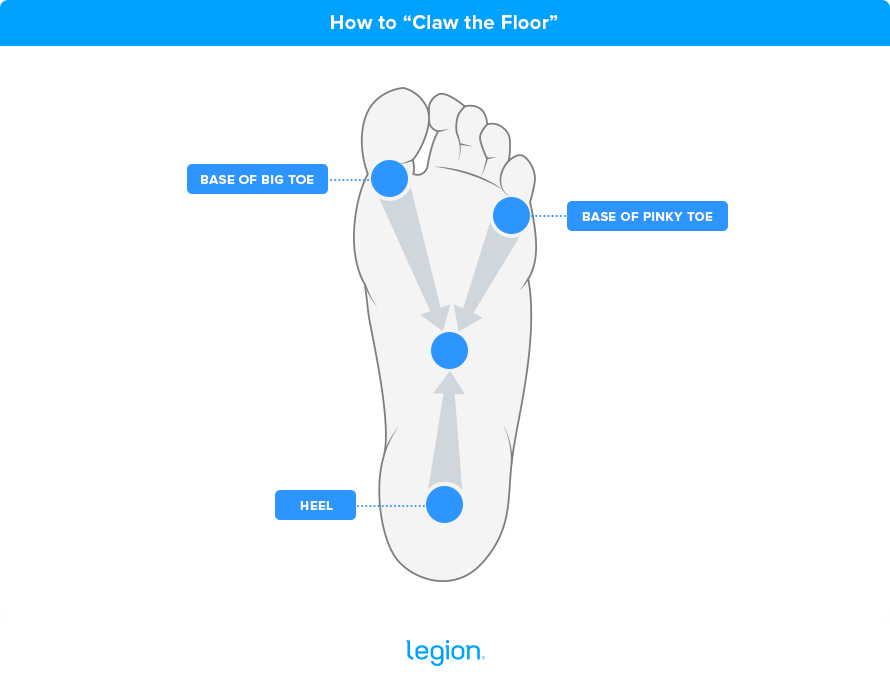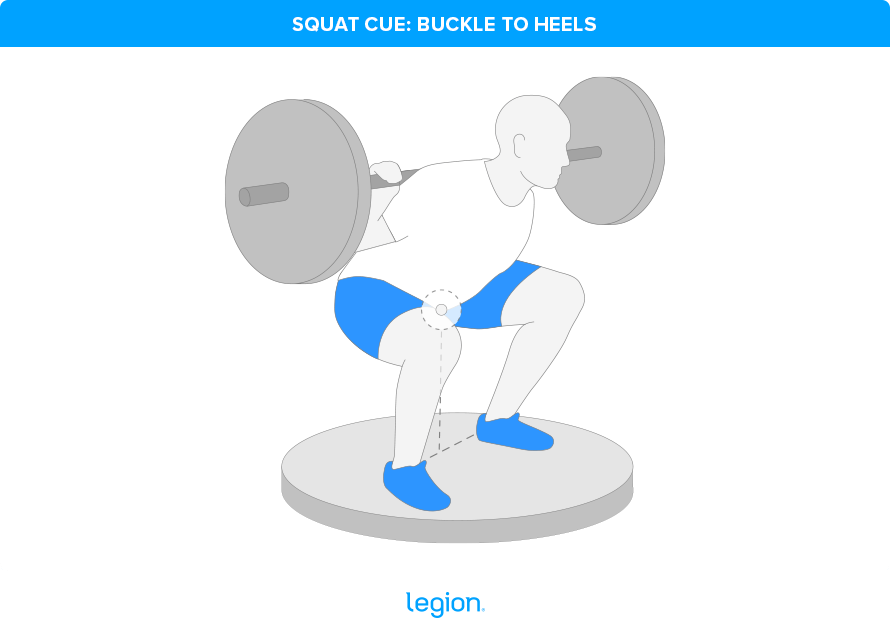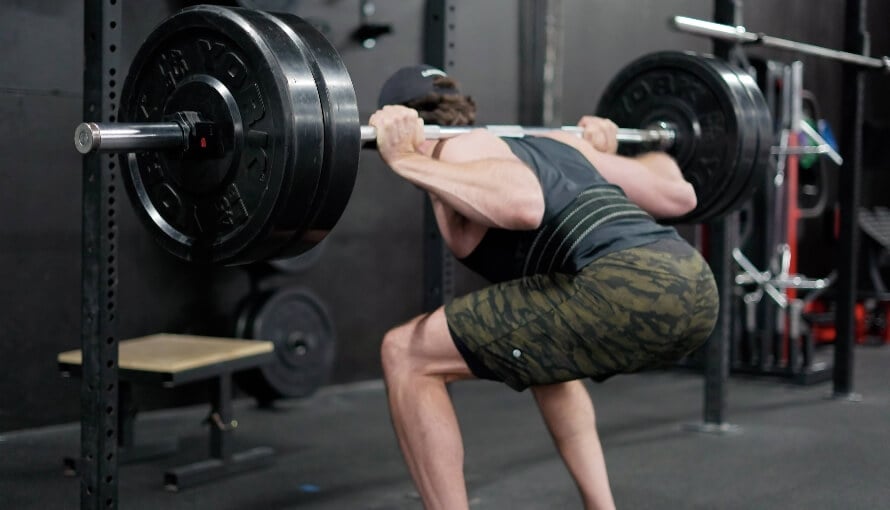Evidence Based
Perfecting your form for squats can feel like solving a puzzle.
You know something isn’t quite right, but no matter how much you tweak your stance, back angle, and bar position, it still feels off.
For many squatters, the key to going from good squat technique to picture-perfect form is mastering a few simple squat cues.
In this article, I’ll share 9 of my favorite barbell back squat cues to help you perfect your squat form, rep after rep.
- The 9 Best Squat Cues for Perfect Squat Form
Table of Contents
+
The 9 Best Squat Cues for Perfect Squat Form


1. Lift the Boulder
When to Use: Just before unracking the barbell.
Why it Works: A common mistake when squatting is only engaging the muscles the bar touches—the rear delts and traps. To squat heavy weights safely, though, you need your entire back involved. Only then can you properly support and balance the load.
Imagining the bar as a boulder covering your entire back helps you engage every muscle from top to bottom, which reduces injury risk and allows you to lift heavier weights.
2. Eyes on the Horizon
When to Use: Throughout each set.
Why it Works: Maintaining proper squat form with a bar on your back becomes tough if you tend to look downward. Looking at your feet can pull your chest down, round your back, and drag you off balance. A reliable back squat coaching cue to stay upright and stable is to fix your eyes on the horizon.
Just be careful not to tilt your head back—”the horizon” works, but “the stars” are too high.
3. Claw the Floor
When to use: Throughout each set.
Why it works: While it’s safe for your knees to pass your toes during squats, allowing them to pitch too far forward can cause your heels to lift, which shifts your center of gravity and increases injury risk.
A solid coaching cue for squatting without this issue is to “claw the floor.” Imagining pulling your big toe, pinky toe, and heel toward the center of your sole activates the muscles in your feet and lower legs, and creates a stable base for lifting heavy weights.
Here’s an illustration to help you visualize this:


4. Elbows in Your Pockets
When to use: Throughout each set.
Why it works: To support heavy weights and maintain proper squat form, you need to engage your entire back. But some find firing up the lats tricky. A useful squat coaching cue for these folks is to imagine putting your elbows in your back pockets.
Using the squat cue “bend the bar” can also work, though some people dislike it because it can make you tip forward. “Elbows in pockets” keeps your upper back tight without disrupting your form, which is why I prefer it.


5. Ribs Down
When to use: Throughout each set. You’ll need to reset it every time you take a “belly breath” and brace.
Why it works: Avoid stressing your lower back by pulling your sternum and belly button closer together using the cue “ribs down.” This keeps your spine in a safe, neutral position, which helps you lift heavier weights safely and efficiently.
RELATED: The Complete Guide to the Valsalva Maneuver
6. Buckle to Heels
When to use: As you descend.
Why it works: “Push your hips back” is a common back squat coaching cue intended to help squatters maintain balance and proper torso angle. If your torso or femur lengths differ from the average, however, it can actually have the opposite effect.
A better squat cue is to imagine bringing your belt buckle (real or imaginary) toward your heels. This works regardless of your anatomy, so no matter your body type, it boosts your balance. Here’s an illustration to help you visualize this:

7. Drive Your Back into the Bar
When to Use: As you ascend.
Why it Works: Forcefully driving your back into the bar as you begin standing up prevents you from leaning too far forward, which helps you lift the weight more efficiently.


8. Explode from the Hole
When to Use: As you ascend.
Why it Works: The hardest part of each rep for most squatters is just after they come out of “the hole,” when their legs are slightly above parallel. The cue “explode from the hole” reminds you to drive upward forcefully from the bottom, push through the “sticking point,” and complete the rep powerfully.
9. Spread the Floor
When to Use: As you ascend.
Why it Works: If your knees cave inward as you stand up in the squat, imagine spreading the floor apart with your feet. While your feet won’t actually move, thinking about driving them outward helps keep your knees in line with your toes, engages your glutes, and enables you to lift more weight with a lower risk of pain or injury.
Scientific References +
- Yavuz, Hasan U., and Deniz Erdag. “Kinematic and Electromyographic Activity Changes during Back Squat with Submaximal and Maximal Loading.” Applied Bionics and Biomechanics, vol. 2017, 2017, pp. 1–8, https://doi.org/10.1155/2017/9084725.
- Larsen, Stian , et al. New Insights about the Sticking Region in Back Squats: An Analysis of Kinematics, Kinetics, and Myoelectric Activity. 7 June 2021, www.frontiersin.org/journals/sports-and-active-living/articles/10.3389/fspor.2021.691459/full, https://doi.org/10.3389/fspor.2021.691459. Accessed 7 June 2021.
You May Also Like
You don’t need supplements to build muscle, lose fat, and get healthy. But the right ones can help.
Take our 60-second quiz now to learn which supplements can help you achieve your fitness goals faster.
Sending…
Your free stuff is on the way!
Follow the Diet Plan that Helped Nikita Lose 15 Pounds in 3 Months
“I never thought getting in shape would be this simple! Everything just WORKS when you follow this plan.” And if he can do it, why not you?


Wait!
Want a Free Custom Meal Planning Tool?
Quickly calculate your calories, macros, and micros for losing fat, building muscle, and staying healthy.
Our “No Return Necessary”
Money-Back Guarantee
If you don’t like something of ours, guess what happens next?
No, we don’t request you deliver it to a PO box in the Gobi Desert by carrier pigeon. Nor do we ask you to fill a cursed inkwell with orc’s blood and demon saliva and then use it to complete reams of return forms written in ancient Cyrillic script.
We just . . . wait for it . . . give you your money back. Holy moo cows. And that means you can say “yes” now and decide later.
Free Worldwide Shipping & Returns
Many companies use shipping and handling fees to increase their profit margins, but here at Legion, we hate profits, so our shipping is free!
Okay, so we do dig on profits, but we also go in for happy customers, and free shipping works like gangbusters. So, if you live in the United States, your order ships free regardless of order size, if you live in the UK, Canada, Puerto Rico, or Guam, your order ships free when it’s over $99, and if you live elsewhere, your order ships free when it’s over $199.
Also, if you don’t absolutely love our stuff for whatever reason, we don’t request you deliver it to a PO box in the Gobi Desert by carrier pigeon.
We just . . . wait for it . . . give you your money back. No returns. No forms. No nonsense. Holy moo cows.
That means you can say “yes” now and decide later. You really have nothing to lose.
Free Worldwide Shipping & Returns
Many companies use shipping and handling fees to increase their profit margins, but here at Legion, we hate profits, so our shipping is free!
Okay, so we do dig on profits, but we also go in for happy customers, and free shipping works like gangbusters. So, if you live in the UK, Canada, Puerto Rico, or Guam, your order ships free when it’s over $99.
Why the restriction on international orders? Unfortunately, shipping abroad is very expensive, and if we didn’t require a minimum order size, we’d lose a lot of money. But! We’re also hustling to improve our international logistics and will be passing our savings along to our international customers.
Also, if you don’t absolutely love our stuff for whatever reason, we don’t request you deliver it to a PO box in the Gobi Desert by carrier pigeon.
We just . . . wait for it . . . give you your money back. No returns. No forms. No nonsense. Holy moo cows.
That means you can say “yes” now and decide later. You really have nothing to lose.
Free Worldwide Shipping & Returns
Many companies use shipping and handling fees to increase their profit margins, but here at Legion, we hate profits, so our shipping is free!
Okay, so we do dig on profits, but we also go in for happy customers, and free shipping works like gangbusters. So, if you’re outside the USA, your order ships free when it’s over $199.
Why the restriction on international orders? Unfortunately, shipping abroad is very expensive, and if we didn’t require a minimum order size, we’d lose a lot of money. But! We’re also hustling to improve our international logistics and will be passing our savings along to our international customers.
Also, if you don’t absolutely love our stuff for whatever reason, we don’t request you deliver it to a PO box in the Gobi Desert by carrier pigeon.
We just . . . wait for it . . . give you your money back. No returns. No forms. No nonsense. Holy moo cows.
That means you can say “yes” now and decide later. You really have nothing to lose.
Split your entire online purchase into 4 interest-free payments, over 6 weeks with no impact to your credit.


25%
today
25%
2 weeks
25%
4 weeks
25%
6 weeks


Shop and add items to your cart as normal!


Choose Sezzle at Checkout! You’ll be redirected to Sezzle to Sign Up or Log In
to complete your order.


Your order will be shipped out right away* and your payments will be split up
over 6 weeks.
*shipping times subject to merchant shipping policy
Shop directory. Reschedule payments. Plus more!
Waiver and Release of Liability
In consideration of the services and/or products offered by Legion Athletics, Inc. (“Legion”) including, but not limited to, nutrition plans, exercise routines and coaching, and in addition to the payment of any fee or charge:
I knowingly and voluntarily enter into this waiver and release of liability and hereby waive any and all rights, claims or causes of action of any kind whatsoever arising out of my use of Legion’s services and/or products, and I hereby release and hold harmless Legion and its consultants, officers, contractors, agents, owners and employees from any and all responsibility, liability, cost and expenses, including for injuries, damages or disorders (physical, metabolic, or otherwise), resulting from my use of Legion’s services and/or products.
I understand that fitness activities including, but not limited to, strength, flexibility, and cardiovascular exercise, with or without the use of equipment, are potentially hazardous activities that involve a risk of injury and even death, and I am voluntarily participating in these activities and using equipment and machinery with knowledge of the risks involved. I hereby agree to assume and accept any and all risks of injury or death related to said fitness activities.
I understand Legion’s services and products are not meant to treat or manage any health conditions or circumstances, and I acknowledge that Legion has recommended I obtain a healthcare provider’s approval for my use of Legion’s services and/or products, through regular physical examination(s) and/or consultation. I acknowledge that I have obtained my healthcare provider’s approval or have decided to use Legion’s services and/or products without such approval and hereby assume all responsibility for my use of said services and/or products.
I understand that results from using Legion’s products and/or services are not guaranteed, and I agree to not hold Legion liable for any outcomes or lack thereof.
OUT OF STOCK
Security Check
Please click the checkbox below. We apologize for the inconvenience.
Fact Checked
Our scientific review board of nutritionists, dietitians, molecular biologists, doctors, and other accredited experts is responsible for reviewing every article, podcast, and video we produce to ensure they’re evidence based, accurate, trustworthy, and current.
Thanks to their connections, credentials, and academic experience, this team of MDs, PhDs, and other professionals has access to a wealth of research published in the largest and most prestigious journals in the world.
This allows them to not only review individual studies but also analyze the overall weight of the evidence on any and all topics related to diet, exercise, supplementation, and more.
If you feel that any of our content is inaccurate, misleading, out-of-date, or anything less than factual, please let us know in the comments section of the article in question.
Evidence Based
We follow a detailed, rigorous, multi-step process to create content that meets the highest standards of clarity, practicality, and scientific integrity.
First, our research associates provide our editorial team with accurate, up-to-date, proven scientific evidence.
Then, our editorial team uses this research to draft articles and outlines for podcasts and videos.
Finally, our scientific review board reviews the content to ensure all key information and claims are backed by high-quality scientific research and explained simply and precisely.
If you feel that any of our content is inaccurate, misleading, out-of-date, or anything less than factual, please let us know in the comments section of the article in question.


